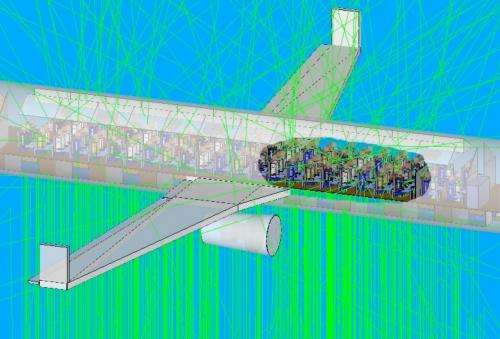Researchers hope to shed light on dark lightning radiation

Scientists now know that thunderstorms, working as powerful natural terrestrial particle accelerators, produce intense flashes of ionizing radiation called "dark lightning." To further their understanding of this phenomena, researchers at the Naval Research Laboratory's Space Science Division are making precise observations of these flashes from space and running detailed simulations to understand the nature of dark lightning and to quantify the radiation exposure it may present to the crew and passengers of aircraft.
Terrestrial Gamma-ray Flashes (TGFs) are extremely intense, sub-millisecond bursts of gamma rays and particle beams of matter and anti-matter. They are associated with strong thunderstorms and lightning, although scientists do not fully understand the details of the relationship to lightning. The latest theoretical models of TGFs suggest that the particle accelerator that creates the gamma rays is located deep within the atmosphere, at altitudes between six and ten miles, inside thunderclouds and within reach of civilian and military aircraft. These models also suggest that the particle beams are intense enough to distort and collapse the electric field within thunderstorms and may, therefore, play an important role in regulating the production of visible lightning. Unlike visible lightning, TGF beams are sufficiently broad—perhaps about half a mile wide at the top of the thunderstorm—that they do not create a hot plasma channel and optical flash; hence the name, "dark lightning."
A team of NRL Space Science Division researchers, led by Dr. J. Eric Grove of the High Energy Space Environment (HESE) Branch, is studying the radiation environment in the vicinity of thunderstorms and dark lightning flashes. Using the Calorimeter built by NRL on NASA's Fermi Gamma ray Space Telescope, they are measuring the energy content of dark lightning and, for the first time, using gamma rays to geolocate the flashes.
As a next step, Dr. Chul Gwon of the HESE Branch is using NRL's SoftWare for the Optimization of Radiation Detectors (SWORD) to create the first-ever simulations of a dark lightning flash striking a Boeing 737. He can calculate the radiation dosage to the passengers and crew from these Monte Carlo simulations. Previous estimates have indicated it could be as high as the equivalent of hundreds of chest X-rays, depending on the intensity of the flash and the distance to the source. SWORD simulations allow researchers to study in detail the effects of variation in intensity, spectrum, and geometry of the flash. Dr. Grover's team is now assembling detectors that will be flown on balloons and specialized aircraft into thunderstorms to measure the gamma ray flux in situ. The first balloon flights are scheduled to take place this summer.
Provided by Naval Research Laboratory



















